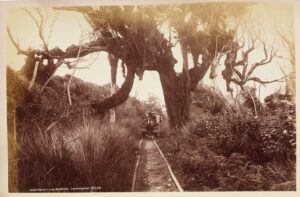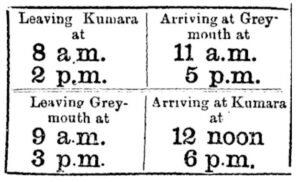1877: The Greymouth and Kumara Tramway
December 3, 2022
By AHNZ

The Kumara gold rush of 1876 opened up a new source of wealth which the nearby port towns of Hokitika to the south and Greymouth to the north obviously wanted to form a supply line with. To the east of Kumara, to this day, is the much longer road all the way to Christchurch so that city too could get a piece of the action.
There was plenty of action while the gold lasted. Kumara was soon bestowed with its own Borough Council and own seat in the House of Representatives and these were both called Kumara too. Politician Richard Seddon quickly moved in and started his Queen’s Hotel and became the first Mayor and first MHR for Kumara, propelling him to greater power including his eventual premiership. Ref. 1893: Richard Seddon assumes Premiership of New Zealand, AHNZ
Hokitika had the jump on Greymouth meaning that precious commerce and gold was flowing through their town first. It’s true that the approach from the Greymouth side had a deep, wide, and swift Taramakau River to contend with. However, it’s also probably true that parochial politicians loyal to Hokitika did all they could to hold back the Greymouth to Kumara Tramway from being completed. Construction was delayed due to “vexatious obstructions” until November 1876 and then progress retarded by politics so that in December that year residents had to petition The Vogel Gang in Wellington for permission to continue. Ref. The Continuous Ministry, AHNZ and Ref. Grey River Argus (22 December 1876,) Papers Past
Bush tramways were far from unusual in New Zealand or on the West Coast. The bloodstream and nervous system of the New Zealand leviathan has evolved over time to include mail pigeons, Twitter, telegraph, motorways, whalers, Maori runners, coastal traders, airmail, and locomotives on rails. These horse-drawn railways belong to a little documented era in our natural evolution which seem a bit primitive but which were a giant leap forward in terms of communications infrastructure. Anyone who has tried to cross through virgin bush or swamp or soggy soil, especially in winter, apprehends how valuable a well-drained and reliable track is.
With some native timber and some hard work the Greymouth to Kumara Tramway was soon a lifeline pumping new life from the new goldfields into Greymouth. It opened on 2 May, 1877. We are fortunate to have several photos of which the following discovered by History Geek may be one…
I look at History Greek’s picture and I see lots of hard work.
Check out how thick that bush is; You must clear it. Not just clear it but pull stumps one at a time by driving a horse or bullock. Now the ground needs to be leveled. We’re ready to begin…
Then come rough logs cut from the bush one at a time. Thousands of them piled in a tidy row side-by-side. On top of that comes the wooden rails end-to-end and all bound together by sleepers to bind them. Lots of hammering and milling. Level them out, make sure they’re straight. Now pick and shovel some earth (or sand if you can get it) from the gnarly soil of root and rock. One shovel at a time, cover up all those logs and sleepers.
Exhausting efforts! Very worthy of a photograph being taken.
You can see from History Geek’s photo how the tramway was made of raised ground above the damp forest floor. Thousands of native timbers running orthogonaly to the tramline form a foundation. Now there was something one of the tramway horses could pull a cart along for a fee. Pedestrians were also allowed to walk the road for a fee. This technique ancient and quick and inexpensive.
Similar technology from 1850s Dunedin was preserved in 2021 and called a ‘corduroy causeway.’ As a “…category 1 historic place and an estimated $400,000 was spent preserving it and putting it in a temperature and humidity-controlled display unit.” Ref. Cause for celebration, ODT; AHNZ, Facebook (2021)
We can be sure the tramway needed to be maintained frequently from falling branches and trees and washouts. Especially so in winter and in the spring rains. The pre-existing part of the tramway from 1868 from Greymouth to Paroa was washed out within a year of being created. The horses were worked hard too and had their own recovery paddock along the way next door to Karoro Cemetery¹.
The tramway was broken at the Taramakau where another means of crossing had to be found. This job was taken care of by a steam-powered cable car called ‘The Cage’. That’s the way it had to be until a road-rail bridge came along for this river on 18 December 1893. This bridge was not replaced until 22 July 2018 but remains in service as a rail bridge with its distinctive red paint. Incidentally it was here that explorer Henry Whitcombe drowned in 1863 after having come all the way over from Christchurch with the agenda of stopping both Greymouth and Hokitika from drawing off all the gold and siphoning it off to Melbourne.
“Following the gold rush of 1876, a horse drawn wooden tramway was built between Greymouth and Kumara, Westland. The trip took three hours. Trams carried passengers and freight. Passengers had to cross the Taramakau River in a cage or flying fox suspended from a cable.” – Wagon on Greymouth to Kumara wooden tramway in Taramakau bush, National Library
“Owing to vexatious obstructions, work was not fairly commenced until the latter part of last November, and even after operations had been entered upon an attempt- was made from a quarter whence it was least to be expected to retard progress. Notwithstanding all this the work of clearing the bush and laying the rail was steadily carried on and now at the expenditure of the comparatively trifling sum of L5000 the company is possessed of a line of tramway which, had its construction been undertaken by Government “engineers” (whose ideas seem to be as crude as their surveys are tortuous) would doubtless have cost ten times the amount.” – Grey River Argus (1877,) Papers Past
The Greymouth Greenstone Tramway Company Ltd. (1868)…”ran as far as Paroa…the line was run from…present railway crossing Tainui Street…for a very long time the only thoroughfare out that way…When Kumara broke out this line was continued to the Taramakau River, which was crossed in a cage, and passengers then took the Kumara tram to the latter town.” – Jackson (p27, 1968)
“Kumara was on the south bank of the deep, wide and swiftly-flowing Taramakau river. As a result, Hokitika initiallky dominated supplying the new goldfield…The merchants of Greymouth showed great initiative to share in the lucrative Kumara trade. They quickly formed a company to extend their Paroa tramway to the north bank of the Taramakau. There they constructed a steel-cabled aerial ropeway across the formidable river.” – Rosanowski (p18, 2012)
“But a population based on alluvial gold diggings is liable to fluctuate rapidly so that many of these West Coast tramways were short-lived. However, a track laid in 1877 from Greymouth to Kumara remained in use until 1893 and trams still ran from Hokitika to Kaniera until 1906.” – NZH (p1794, 1971)
 One of the great things about the The Greymouth and Kumara Tramway and its 16 years of life is that it was not a government project. The Grey River Argus rightly pointed out that government only gets in the way, does a poor job, and costs some 10x more to achieve the result. In the 2000s Coasters, or any New Zealand community, would not be so proactive in their own lives when they saw something that needed doing. Today Kiwis would not beg to be left alone to build. Today Kiwis would beg Central Government to give them what they want and, worse, even beg Wellington to think up what it is we should want as well as supply it! We have become relatively infantalised and dependent compared to our 1860s ancestors.
One of the great things about the The Greymouth and Kumara Tramway and its 16 years of life is that it was not a government project. The Grey River Argus rightly pointed out that government only gets in the way, does a poor job, and costs some 10x more to achieve the result. In the 2000s Coasters, or any New Zealand community, would not be so proactive in their own lives when they saw something that needed doing. Today Kiwis would not beg to be left alone to build. Today Kiwis would beg Central Government to give them what they want and, worse, even beg Wellington to think up what it is we should want as well as supply it! We have become relatively infantalised and dependent compared to our 1860s ancestors.
The Greymouth and Kumara Tramway was a private company that took nothing from the taxpayer and returned great value to their community. Anarchist Libertarians are frequently called upon to answer the route question from Statists: “But how will you build the roads?” This old tramway, and scores more like it in Colonial New Zealand, answer that question.
—
1 The Golden Grey, Tony Kokshoorn (2011)
Image ref. James Ring; photographer; circa 1880; West Coast, Museum of New Zealand
Note: Same tree viewed from other side in this photo, Ref. Alexander Turnbull Library, NZH&NZ
Image ref. Tramway timetable, Kumara Times (17 May 1877;) Papers Past
Image ref. Taramakau Cable Car, ‘The Cage’, West Coast History
Image ref. Bush Tramway. Which one? Unknown. History Geek (2021,) Facebook
Ref. Greymouth The First 100 Years, Ossie Jackson (1968)
Ref. New Zealand’s Heritage (1971)
Ref. A History of the West Coast of the Southern Alps, John Rosanowski (2012)
Ref. Cantabrians in 1865 very concerned to establish a road to the West Coast goldfields too. Henry Whitcombe had already been scarified to that cause. Punch in Canterbury, Alexander Turnbull Library
 Like Comment Share
Like Comment Share





